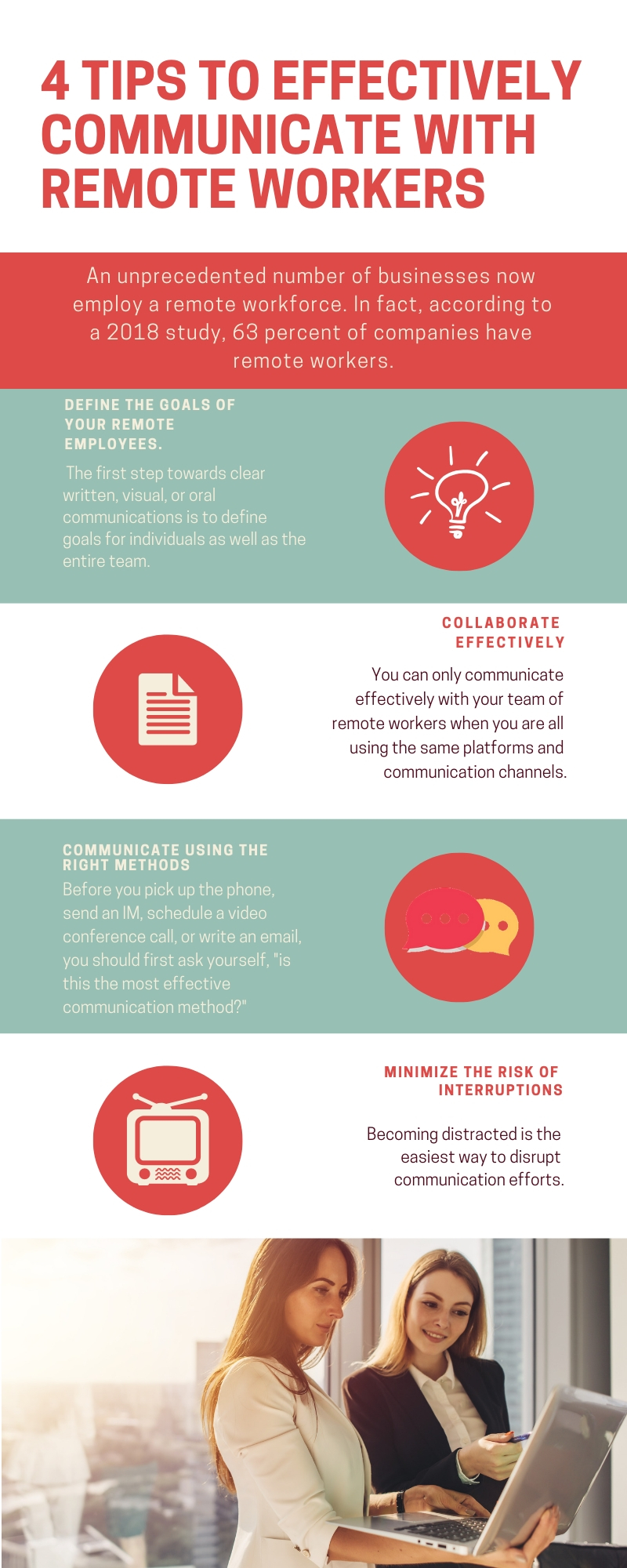An unprecedented number of businesses now employ a remote workforce. In fact, according to a 2018 study, 63 percent of companies have remote workers. Unfortunately, of these companies, approximately 70 percent do not have a remote worker policy. Without a policy in place, many businesses are faced with communication challenges. In fact, for any sized business who relies on remote workers, it is now more critical than ever that the most effective communication channels are leveraged to increase efficiencies, improve operating capacities, and inevitably enhance the bottom line.

Understanding The Increasing Number Of Individuals Working Remotely
Communicating clearly is often the lynchpin to business success. However, for many businesses, communicating with remote workers can be a challenge. In fact, according to a recent study, companies often overlook the humble phone call in favor of verbose written communications. Of the 41 million Americans who work independently, an estimated 29 percent want to be communicated with via the phone. Another 13 percent prefer text messages as the first line of communication, while 7 percent want to have video conferences when speaking with on-site employers and team members. These statistics showcase the importance of establishing clear communications channels that can be used to effectively build businesses, increase productivity levels, and offer valuable insights to both on-site teams and remote workers.
How To Effectively Communicate With Remote Workers
While many employers feel that it is harder to communicate effectively with remote workers, the truth of the matter is that with the right approach the latter challenge can easily be overcome. The following four tips can help you to concisely and clearly communicate with your team of remote workers.
- Define The Goals Of Your Remote Employees. — The first step towards clear written, visual, or oral communications is to define goals for individuals as well as the entire team. The specific goals for your remote employees will depend on the nature of your team’s project. However, it is important to note that the process for determining said goals should be the same as the steps that you take when establishing the goals, tasks, and expectations for your internal team members. For example, if you are part of an IT sales team, then your goals might be to increase sales by 20 percent in Q4. The steps needed to achieve this goal should be clearly laid out, every team member should know the role that he or she plays, and you should create direct feedback loops to encourage collaboration.
- Collaborate Effectively. — You can only communicate effectively with your team of remote workers when you are all using the same platforms and communication channels. In this vein, you need to ensure that both your internal and remote teams are using the same emailing, video conferencing, and instant messaging platforms. Additionally, you will want to ensure that everyone is using the same calendar app or platform. Far too often calendar invites to remote-access meetings are lost or ignored when a central scheduling tool isn’t used. Finally, by just using the same communication and scheduling platforms, you can streamline collaboration efforts to further increase productivity levels and create an environment for clear communications.
- Minimize The Risk Of Interruptions. — Becoming distracted is the easiest way to disrupt communication efforts. Just as you can close your office door when you are on an important phone or video call, so too should you encourage your remote workers to create distraction-free work zones. You should also learn the work patterns of your remote employees, so that you can plan on calling, messaging, or hosting video conferences at a time when they are free to chat and not busy working on a deadline or otherwise avoiding distractions.
- Communicate Using The Right Methods. — Before you pick up the phone, send an IM, schedule a video conference call, or write an email, you should first ask yourself, “is this the most effective communication method?” Keep in mind, that when misused, even the best communication tool can have adverse effects. As a general guideline, emails should typically be used for single messages, scheduling video meetings, or sharing files with your remote team. IM can be an excellent tool for discussing specific aspects of a project, while a phone call is essential for an in-depth discussion. Finally, a video conference is the ideal choice when you want to share computer screens, review presentation notes, or have a large amount of information to review in-depth.
The Bottom Line: Adopt The Communication Style That’s Optimal For Your Remote Workforce
No matter the industry, the success of every business hinges on clear, effective, and open communications with both their internal and remote teams. The more time that you can spend getting to know the work habits and communication preferences of your remote employees, the easier it will be for you to not only communicate effectively, but to also increase productivity levels, establish an environment of streamlined collaborations, and achieve vital business goals.
Contact Us

